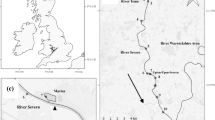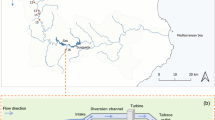Abstract
The distribution and behaviour of larval and juvenile perch (Perca fluviatilis L.) were studied for two years in large, deep Lake Constance. After hatching larvae were transported by water currents to the open water. The majority of larvae remained in the pelagic zone for about one month. In both years, their return to the littoral zone coincided with the decline of pelagic zooplankton abundance. After returning to the littoral zone, juveniles stayed among submerged macrophytes within 5 m depth and lived apart from larger perch which lived at depths of 6–20 m. By late summer, juveniles changed their distribution pattern: during the day they stayed intensively close to piers and ports, but increased their swimming activity at dusk, cruising among shallow and deep waters and feeding on zooplankton, and rested on the bottom at night. This behaviour appears to be related to the decrease of inshore food resources and to the presence of predators in deeper water. 0+ perch left the littoral zone and moved into deep waters when autumnal mixing began in late October. They overwintered near the bottom at depths of more than 30 m. During most of the year, juvenile and adult perch were separated from each other. But as soon as they occupied the same habitat, the occurrence of cannibalism increased.
Similar content being viewed by others
References
Ali, M. A., R. A. Ryder & M. Anctil, 1977. Photoreceptors and visual pigments as related to behavioral responses and preferred habitats of perches (Perca spp.) and pikeperches (Stizostedion spp.). J. Fish. Res. Bd Can. 34: 1475–1480.
Amann, E., 1975. Nahrungsumstellung und Zunahme der Barsche (Perca fluviatilis) im Bodensee-Obersee infolge Eutrophierung. Österr. Fisch. 28: 72–76.
Becker, M., 1988. Freilandökologische Untersuchungen an planktivoren Fischen des Überlinger Sees mit Schwerpunkt einer differenzierten Nahrungsanalyse. M. Sc. thesis, University of Constance.
Coles, T. F., 1981. The distribution of perch,Perca fluviatilis L. throughout their first year of life in Llyn Tegid, North Wales. J. Fish Biol. 18: 15–30.
Craig, J., 1987. The biology of perch and related fish. Croom Helm, London: 333 pp.
Geller, W., 1986. Diurnal vertical migration of zooplankton in a temperate great lake (L. Constance): A starvation avoidance mechanism? Arch. Hydrobiol. Suppl. 74: 1–60.
Hartmann, J., 1975. Der Barsch (Perca fluviatilis) im eutrophierten Bodensee. Arch. Hydrobiol. 76: 269–286.
Hartmann, J. & H. Löffler, 1989. Tiefenverteilung der Fische des Bodensees. Österr. Fisch. 42: 236–240.
Hartmann, J. & W. Nümann, 1977. Percids of Lake Constance, a lake undergoing eutrophication. J. Fish. Res. Bd Can. 34: 1670–1677.
Houde, E. D., 1969. Distribution of larval walleyes and yellow perch in a bay of Oneida Lake and its relation to water currents and zooplankton. N.Y. Fish Game J. 16: 184–205.
Knauer, K., 1991. Vergleich litoraler Biozönosen vor verbauten und unverbauten Uferabschnitten des Bodensees (Konstanz-Egg). M. Sc. thesis, University of Constance.
Krämer, A. & C. Baroffio, 1988. Nahrungswahl und Kannibalismus beim Barsch (Perca fluvatilis) des Bodensee-Obersees. Schweiz. Fischereiwissensch. 2: 3–4.
Nellen, W. & D. Schnack, 1974. Sampling problems and methods of fish eggs and larvae investigations with special reference to inland waters. In: EIFAC symposium on methodology for the survey, monitoring and appraisal of fishery resources in lakes and large rivers. Oben, Scotland. Contribution No. 57.
Nümann, W., 1939. Untersuchungen über die Biologie einiger Bodenseefische in der Uferregion und den Randgebieten des freien Sees. Z. Fisch. 37: 637–688.
Post, J. R. & D. J. McQueen, 1988. Ontogenetic changes in the distribution of larval and juvenile yellow perch (Perca flavescens): a response to prey or predators? Can. J. Fish. aquat. Sci. 45: 1820–1826.
Tarby, M. J., 1974. Characteristics of yellow perch cannibalism in Oneida Lake and the relation to first year survival. Trans. am. Fish. Soc. 3: 462–471.
Treasurer, J. W., 1988. The distribution and growth of lacustrine 0+ perch,Perca fluvatilis. Envir. Biol. Fish. 21: 37–44.
Wang, N., 1993. Food and Feeding of young perch (Perca fluviatilis L.) in Lake Constance. Verh. Int. Ver. Limnol. 25. (in press).
Whiteside, M., C. M. Swindoll & W. L. Doolittle, 1985. Factors affecting the early life history of yellow perch,Perca flavescens. Envir. Biol. Fish. 2: 47–56.
Author information
Authors and Affiliations
Rights and permissions
About this article
Cite this article
Wang, N., Eckmann, R. Distribution of perch (Perca fluviatilis L.) during their first year of life in Lake Constance. Hydrobiologia 277, 135–143 (1994). https://doi.org/10.1007/BF00007295
Received:
Revised:
Accepted:
Issue Date:
DOI: https://doi.org/10.1007/BF00007295




